Last month saw the passing of David Miller, one of our founder members and an inspiration to the Group, who will be greatly missed. Another Guernseyman, John Ogier, has penned a fitting tribute below. We also saw the arrival of a new coalition government in the UK. Although we know that cutting the countries deficit will be their major priority it is too soon to tell how this will impact on our industry. However, equally important for many will be how the world's money markets value the pound in relation to the countries we deal with. At present the weakness of the pound against the dollar helps exporters to the USA while the extreme weakness of the Euro is making fruit and flower imports cheaper and exports more expensive.
Editor
- If you have an article that you think would be of interest, please contact: Sue Grimbly scihortigroup@btinternet.com
David Miller MBE

The holder of an MBE for his services to horticulture. David was a quiet spoken man with a rich personality, a big heart for people and blessed with a sense of humour. A person who it was a privilege to know and work with.
David studied at Writtle College of Agriculture and Horticulture, obtaining an Advance Diploma of Horticulture and subsequently a National Diploma for Horticulture.
Early in his career in February 1969, David came to Guernsey to take up an appointment with States of Guernsey Horticultural Advisory Service. His knowledge, hard work and practical understanding saw him oversee major advances in crop production; especially in glasshouse roses and ornamental plants. In 1979 he was appointed senior advisory officer for flowers and ornamental crops. In 1986 he became director of the Horticultural Advisory Service. Under his leadership the industry developed new areas of diversification and enterprise.
However with the decline in tomato production and subsequently cut flowers in Guernsey, David was the last person to hold the post of Director. David took early 'retirement' in March 1992 at his own request, but not to a life of inactivity. Between 1992 and 2006 he became general manager of Guernsey Clematis Nursery, driving forward innovation and ISO 9000 certification in a world leading business. His consultancy work also continued to develop with commissions from the Eden Project and Heligan Gardens among many others.
David had the rare ability to combine both scientific plant knowledge with a practical understanding and creative flair. His creative triumphs included RHS Chelsea Flower Show gold medals and awards at Hampton Court Flower Shows.
All through his career David had been an advocate for horticulture on the national and international stage. In September 2004 he became the President of the Institute of Horticulture and subsequently a founder member of the SCI Horticulture Group. This brought many challenges as well as opportunities in addressing the changing role of horticulture on a national and global scale.
This was perhaps most graphically expressed in the joint IoH –Eden project stand at Chelsea in 2005. The display centered on the global garden of the world facing the challenges of global warming, pollution, increasing food production needs and habitat destruction. Yet the stand also pointed the way for horticulture in the future with the development of bio-fuels like willow and Miscanthus along with biotechnology developing new symbiotic relationships between man, insects and plants in providing solutions to the world problems.
This is the way I believe David would wish to be remembered in horticulture, not so much for his service and achievements through his life, but also looking forward with a 'prophetic' voice, stirring our imaginations and ideas to apply professional knowledge and plant skills to the challenging world in which we live.
John Ogier
Millennium Seed Bank Tour 18 May 2010
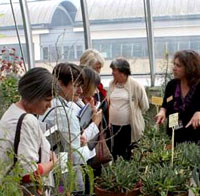
Originally set up under a Millennium lottery grant the initial objective was to collect 10% of the world's species. Seed of a banana Musa itinerans saved in October 2009 was the 24,200th sample and marked the achievement of this goal. They are now working towards saving 25%. This will require £100million to fund, though as Kate pointed out this is what is spent on cosmetics and perfumes - every second! The initial target was very much a number target and, while MSB makes every effort to ensure the seed samples are representative of the species they have not so far been able to take much account of sub-species, ecotypes and other intra-specific variations.
They work with institutions in 18 countries through formal agreements and less formally with some 100 institutions in around 50 countries. Under these agreements the rights to use the seed are controlled by the country of origin. Each agreement varies as to what can be done with the seed by way of research, passing to third parties and commercialisation.
Seed is collected by the overseas institutions with half stored in the home country and half sent to the seed bank at Wakehurst. We were shown how first the seed is ripened, if necessary, before being cleaned and then dried for several weeks at 15%RH at 15oC. Finally the seed is placed in a variety of airtight containers for storage in the seed bank vaults at -20oC. 50% of each sample is kept in a separate store from which samples can be taken for the many projects the seed bank is involved with. These range from species reintroduction to helping local farmers integrate with their natural environment to enable both them and their environment to flourish.
This simple description hides a whole series of records and traceability checks that follow the seed samples through the building to ensure that the origin, identity and viability of the seed is accurately known. However, that is not the end of the story for, having stored the seed, it is essential to know how best to germinate it when required and not all seeds leap into life just on contact with water. Some require damage to the seed coat by scratching or chipping, while other require more specialist treatment. For example species adapted to colonising after fires respond best to a combination of heat and exposure to butenolides produced in the smoke.
They also need to know how long the seed will survive in cold storage and use extrapolation techniques to show that some will survive as little as 25 years while other are estimated to remain viable for over 6,000 years. The result is that the seed bank may seem to be a collection of seeds in a cold store but each sample has allied to it a whole catalogue of information from when, where and how to collect the seed through its identity and how to germinate it to the most favourable conditions in which it will grow.
Plants of the Month
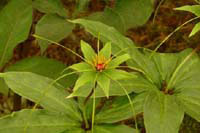 |
| Paris polyphylla (above) and quadrifolia (below) |
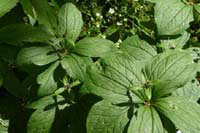 |
Herb Paris
Paris polyphylla and Paris quadrifolia (Melanthiaceae)
June brings the start of the flowering season of Paris polyphylla, a stunning addition to any shady, slightly damp area of the garden. The name does not indicate origins in France nor any link with the Trojan War, but rather is derived from the Latin par, meaning equal, referring to the regularity of the flower parts.
Polyphylla means many-leaved. Herb paris originates from the Himalayas where it can be found growing in woodlands and forests. It is a rhizomatous plant and the rhizomes have been found to contain a plethora of interesting medicinally useful natural products having a wide range of uses.
Photo: Paris polyphylla
Our native counterpart, Paris quadrifolia, having only four leaves around the stem below the flower is slightly less showy but beautiful in its own right. It is mainly found in alkaline soils in damp woodland in the east of England.
Photo: Paris quadrifolia
The family Melanthiaceae was formerly included in the Liliaceae but has been recognised as a separate family by the Angiosperm Phylogeny Group. Trilliums, which are closely related to Paris are also in Melanthiaceae.
Alison Foster
Medicinal Plant of the Month
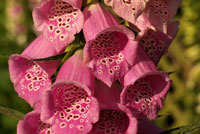 |
| Digitalis purpurea (above) and lanata (below) |
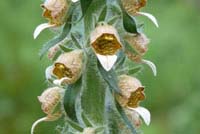 |
Common purple foxglove
Digitalis purpurea
In the latter part of the 18th Century, William Withering, a physician and member of the Lunar Society, became interested in the case of a lady who recovered from a severe case of dropsy after taking a herbal mixture. After extensive investigation he found that the purple foxglove was the plant responsible for the seemingly miraculous recovery of the patient. He began experimenting with foxglove to treat other patients and found it to be very successful with patients suffering from what we now know to be congestive heart failure (dropsy).
It was not until the 1930s that scientists at Burroughs Wellcome isolated the active principle, digitoxin, from the foxglove and determined its structure. Digitoxin is a cardiac glycoside and works by strengthening and slowing the heart beat. It is still used today, but a related molecule, digoxin, isolated from the woolly foxglove, Digitalis lanata, is more widely used as it is more effective and is excreted more rapidly from the body, making it safer.
Alison Foster
 |
| Digitoxin (above) and digoxin (below). Note the two additional hydroxyl groups |
 |
Horticulture Industry News
The new UK government ministers:
David Willetts, Minister of State for Universities and Science
Mr Willetts has a reputation for intellect and picked up the nickname 'two brains' among the Westminster press corps. Like all government portfolios, science will have to operate in the shadow of efforts to reduce the public deficit. The Tories promised the research sector a multi-year, 'stable investment climate' in their election campaign. However they made no commitment to maintain Labour's supposed 'ring fence' of science funding.
Caroline Spelman, Environment Secretary
Before entering Parliament, Mrs Spelman had an extensive career in the agriculture sector, with fifteen years in the agriculture industry and in-depth experience of the international arena, including as deputy director of the International Confederation of European Beet Growers and a research fellow for the Centre for European Agricultural Studies. She has also authored a book on the non-food use of agricultural products.
Protected Crop Survey
The European Food Safety Authority's survey of protected cropping systems has now gone live. If you use any form of structure to protect your crop please complete this survey. In doing so you can help ensure a robust evidence base is provided to direct future policy decisions.
How big is it?
Scientists from the National Physical Laboratory, in collaboration with KMS projects and Vegetable Harvesting Systems, have developed technology that will allow machines to identify the size of vegetables through the use of infra-red, terahertz and radio frequencies, which can then be utilised in fully automated harvesting machines. It is hoped that this will reduce wastage and help with the problem of a dwindling supply of migrant workers available to hand pick. (International Supermarket News, April 2010). More
From weed to oil crop
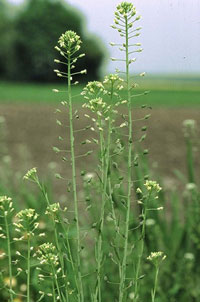
Photo: False flax, Camelina sativa (Fornax)
UK apricots
A good quality domestic apricot crop is expected to make its appearance on UK retail shelves this summer. Early indications are for a very good crop due to plenty of chilling hours over winter and high UV levels during and after flowering.
(Fresh Produce Journal, 7 May 2010)
Earthworms eat seeds and seedlings
The discovery they eat live rather than just dead plants will change the way we think about earthworms, which had been thought to benefit plants by recycling soil nutrients. It may offer a way for gardeners and farmers to encourage more earthworms into their soil, for example. But it also means invasive earthworms could be reducing populations of plants in once pristine soils. Confirmation that earthworms feed on living plants is published in the journal Soil Biology and Biochemistry by Dr Nico Eisenhauer of the Georg-August-Universität Göttingen in Germany. More
EU plans to ban rat poison
Green MEPs are pushing through proposals that could lead to a ban on the use of anti-coagulant rat poison, the main class of chemicals used to control rodent pests. Struan Stevenson, MEP for Scotland, warned the proposal was already ‘well on its way’ through the regulatory system and urged the agricultural industry and fellow politicians to step up their game to stop it in its tracks, 'This is not scaremongering, there is a real possibility that we could see a ban on anticoagulant rodenticides – the most widely used group of rodent poisons. If it goes through, farmers will be left without any decent tool to tackle rodents which will result in an infestation not seen for centuries,' he warned. (Farmers Guardian, 30 April 2010).
Flies for pollination
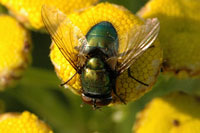
Photo: The greenbottle fly, Lucilla caesar (James Lindsey at Ecology of Commanster)
Abscisic acid help bedding plants
The plant hormone abscisic acid (ABA) regulates drought stress responses by mediating stomatal closure, thereby reducing water loss through transpiration. The effectiveness of ABA at delaying wilting and extending shelf life during drought stress was evaluated in six bedding plant species in work at Ohio state University in collaboration with Valent BioSciences (hortSciences). Overall ABA was consistently effective at reducing water loss and extending shelf life for all species treated. Applications of ABA to bedding plants before shipping and retailing would allow plants to maintain marketability even under severe drought stress conditions (The Commercial Greenhouse Grower, May 2010)
Ignoble rot
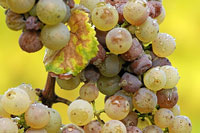
Photo: Noble Rot (Tom Maack)
Writtle wins Bronze at Chelsea
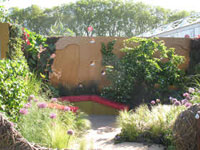
Photo: The Writtle Garden at Chelsea 2010 (Writtle College)
Events Calendar
SCI Events
Food for Thought 2
10 Jun 2010, Food Commodities and Ingredients Group
SCI Headquarters, London, UK
Private Evening Tour of Cambridge University Botanic Garden
10 Jun 2010, Cambridge and Great Eastern Group
Cambridge University Botanic Garden, Cambridge, UK
Evening Tour at Oxford Botanical Garden
11 June 2010, Horticulture Group
Rose Lane, Oxford
SCI BioResources Young Researchers 2010: Crop Productivity, Sustainability & Utility
30 Jun 2010, BioResources Group & Yara
University of Reading, Reading, UK
SCI Annual General Meeting 2010
07 Jul 2010,
SCI Headquarters, London, UK
Committees Workshop & Best Practice Sharing Event
16 Sep 2010, Membership Advisory Committee
SCI Headquarters, London, UK
Horticulture Group Annual General Meeting (AGM) 2010
24 Sep 2010,
SCI Headquarters, London, UK
SCI Members' Forum 2010
9 Nov 2010
SCI Headquarters, London, UK
Other Events of Interest
Advances in molecular plant breeding
8 Jun 2010 - 9 Jun 2010, Association of Applied Biologists
Rothamsted Research, Harpenden, UK
IAFP European Symposium on Food Safety
9-11 Jun 2010, International Association for Food Protection
University College, Dublin, Ireland
4th Global Botanic Gardens Congress
13 Jun 2010 -18 Jun 2010, Botanic Gardens Conservation International
Glasnevin, Dublin, Ireland
International Medicinal and Aromatic Plants Symposium
21Jun 2010 - 24 Jun 2010, International Society for Horticultural Science
Shiraz, Iran
Agriculture Outlook Europe
23 Jun 2010 - 25 Jun 2010, Food Chain CIC
Millenium Mayfair Hotel, London, UK
Landscape management for functional biodiversity
29 Jun 2010 – 1 Jul 2010, International Organisation for Biological & Integrated Control of Noxious Animals & Plants
Cambridge, UK
Thursday July 1st . A day at Bournemouth Parks with Chris Evans including visits to King's Park Nurseries, Boscombe Gardens and Lower Gardens. Organised by John Lockwood (01202 604705)
International Symposium on Improving the Performance of Supply Chains in the Transitional Economies
4 Jul 2010 - 8 Jul 2010, International Society for Horticultural Science
Kuala Lumpur, Malaysia
International Trials Conference: Assessment of Ornamental Plants
6 Jul 2010 - 8 Jul 2010, International Society for Horticultural Science
Guildford, UK
Ohio Short Course
10 Jul 2010 -13 Jul 2010, Ohio Growers Association
Columbus, USA
Woking Nursery Exhibition
14 Jul 2010, Woking Nurseries
Merrist Wood College, Worplesdon, Surrey, UK
Fruit Focus
21 Jul 2010, Haymarket
East Malling, UK
International Symposium on Tomato Diseases
25 Jul 2010 - 30 Jul 2010, International Society for Horticultural Science
Ischia, Naples, Italy
Commonwealth Forestry Conference
28 Jun 2010- 2 July 2010
Edinburgh, UK
Integrated Pest Management---Predator Control etc led by Tony Girard of Koppert
29 Jul 2010, PHGSW
Cantello Nurseries, UK
Eastgro
4 Aug 2010
Petistree, Suffolk, UK
International Workshop on Fire Blight
16 Aug 2010 - 20 Aug 2010, International Society for Horticultural Science
Warsaw, Poland
International Horticultural Congress
22 Aug 2010 - 27 Aug 2010, International Society for Horticultural Science
Lisbon, Portugal
Plantarium
25 Aug 2010 - 28 Aug 2010
Boskoop, the Netherlands
International Symposium on the Genus Lilium
30 Aug 2010 - 3 Sep 2010, International Society for Horticultural Science
Pescia, Tuscany, Italy
International Advances in Plant Virology
5 Sep 2010 - 7 Sep 2010, Association of Applied Biologists
Arnhem, the Netherlands
Four Oaks Trade Show
7 Sep 2010 - 8 Sep 2010
Lower Withington, Cheshire, UK
Delivering Food Security with Supply Chain Led Innovations
7 Sep 2010 - 9 Sep, Association of Applied Biologists
Egham, Surrey
Saltex
7 Sep 2010 - 9 Sep 2010, Institute Of Groundsmanship
Windsor, UK
Abbotsbury Tropical Gardens & Michaud's Chilli, Sweet Pepper and other veg. growing
8 Sep 2010, PHGSW
West Bexington, Dorset, UK
Food Security and Safety Symposium
13 Sep 2010 - 15 Sep 2010, Society for Experimental Biology
Lancaster University, UK
Green Roofs For A Changing Climate
15 Sep 2010 - 16 Sep 2010, London, UK
GLEE
20 Sep 2010 - 22 Sep 2010
NEC Birmingham, UK
International Conference on Organic Greenhouse Horticulture
11Oct 2010 -14 Oct 2010, International Society for Horticultural Science
Bleiswijk, The Netherlands
HortiFair
12 Oct 2010 -15 Oct 2010
RAI, Amsterdam, the Netherlands
Predicting and Controlling the Shelf-Life of Foods
3 Nov 2010 - 4 Nov 2010, Food Chain CIC
Leatherhead, Surrey, UK
Christmas Lunch with Philip Macmillan Browse.
24 Nov 2010, PHGSW
Water and nitrogen use efficiency in plants and crops
15 Dec 2010 -16 Dec 2010, Association of Applied Biologists
Grantham,UK
If you would like to advertise a forthcoming event please contact communications@soci.org.
Horticulture Group Contact Details
For submitting ideas or to volunteer to be part of a committee or a group, please contact:
Acting Chairman - Peter Grimbly
Meetings Secretary - Marion Stainton
Minutes Secretary - Margaret Waddy
Newsletter Co-ordinator - Sue Grimbly scihortigroup@btinternet.com
SCI contact - communications@soci.org T: +44(0)20 7598 1500
